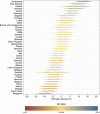Estimating and explaining cross-country variation in the effectiveness of non-pharmaceutical interventions during COVID-19
- PMID: 35534516
- PMCID: PMC9085796
- DOI: 10.1038/s41598-022-11362-x
Estimating and explaining cross-country variation in the effectiveness of non-pharmaceutical interventions during COVID-19
Abstract
To control the COVID-19 pandemic, countries around the world have implemented non-pharmaceutical interventions (NPIs), such as school closures or stay-at-home orders. Previous work has estimated the effectiveness of NPIs, yet without examining variation in NPI effectiveness across countries. Based on data from the first epidemic wave of [Formula: see text] countries, we estimate country-specific differences in the effectiveness of NPIs via a semi-mechanistic Bayesian hierarchical model. Our estimates reveal substantial variation between countries, indicating that NPIs have been more effective in some countries (e. g. Switzerland, New Zealand, and Iceland) as compared to others (e. g. Singapore, South Africa, and France). We then explain differences in the effectiveness of NPIs through 12 country characteristics (e. g. population age, urbanization, employment, etc.). A positive association with country-specific effectiveness of NPIs was found for government effectiveness, gross domestic product (GDP) per capita, population ages 65+, and health expenditures. Conversely, a negative association with effectiveness of NPIs was found for the share of informal employment, average household size and population density. Overall, the wealth and demographic structure of a country can explain variation in the effectiveness of NPIs.
© 2022. The Author(s).
Conflict of interest statement
SF reports membership in a COVID-19 working group of the World Health Organization but without competing interest. SF reports grants from the Swiss National Science Foundation outside of the submitted work. All other authors declare no competing interests.
Figures





References
-
- Hale, T., Webster, S., Petherick, A., Phillips, T., Kira, B. Oxford COVID-19 Government Response Tracker. Blavatnik School of Government. 2020;Available from: https://www.bsg.ox.ac.uk/research/research-projects/coronavirus-governme.... - PubMed
-
- Banholzer N, Weenen Ev, Lison A, Cenedese A, Seeliger A, Kratzwald B, et al. Estimating the effects of non-pharmaceutical interventions on the number of new infections with COVID-19 during the first epidemic wave. Plos One. 2021;16(6):e0252827. doi: 10.1371/journal.pone.0252827. - DOI - PMC - PubMed
Publication types
MeSH terms
Grants and funding
LinkOut - more resources
Full Text Sources
Medical

